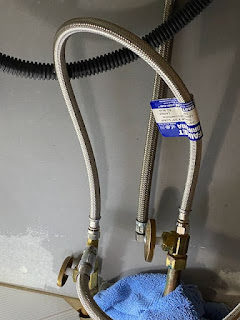A few months back my dishwasher started to get noisy. The wash cycle was taking a very long time, and the dishes were coming out dirty. This turned out to be a water fill problem due to debris in my home's hot water pipes. In the end I solved my dishwasher's problem by flushing my home's hot water pipes. Here is how I solved this problem.
Dishwasher Problem Diagnosis
After a few weeks of awful dishwasher behavior, I ended up opening its door in the middle of a cycle to see what was going on. It sure did look and sound like it was trying to pump water around, but it was clear that the spray was minimal.
At first I imagined the problem was due to a clogged dishwasher filter or bad pump, but after disassembling all those things it was clear they were not the problem.
Then I started to suspect that the dishwasher simply wasn't filling up with enough water.
There was an easy way to test it: just add water. So at the start of a cycle I'd add about a liter of water and then close it up so it could finish the fill cycle. It worked great! This was strong evidence that something was wrong with the filling process.
Was it a clogged fill valve screen, or just a fill valve that was not properly opening? That's what everyone seemed to think, so I replaced the water inlet valve. It didn't help. And at that point, I recalled that my kitchen sink's hot water tap seemed to be slowing down too. Hm.
Further study showed that the dishwasher filling was based on a timer. It would fill up until the float sensor was triggered, or 95 seconds. If it didn't fill up with enough water within 95 seconds, too bad, it would run with whatever water it had.
So there we had it: the hot water flow in my kitchen was so slow that the dishwasher just gave up and would run with inadequate water.
Repair Process: Flushing Hot Water Line
Since the slow hot water was only happening in my kitchen, I concluded that there was debris in my kitchen's hot water plumbing. I could get a plumber in to clean out the water lines for $200+, but heck, maybe I could just flush out the lines myself for free.
There are two sets of water supply piping in my home: HOT and COLD. The HOT system is supplied by the hot water tank, and the COLD system comes directly from outside the building. Since the dishwasher only uses the hot water system, I decided that I should flush it out the hot water pipe by reversing its flow and ejecting as much water (and hopefully debris) out.
Setting up the flush
I disconnected both the hot and cold water flex lines to the kitchen sink's faucet and installed a 2 foot length of braided plumbing hose in their place. This created a "short circuit" between the hot and cold water systems (see the photo). Then I turned off the hot water at the hot water tank. At this point, the hot and cold water systems were merged together.
This setup changed how the hot water plumbing was fed: all the "hot water" taps in the house were getting nothing from the hot water tank, as its valve was closed. Instead, the hot water plumbing was being fed by the cold water pipe in my kitchen. When I opened any hot water tap, water would be coming from the kitchen's hot water line, which was being fed from the kitchen's cold water line.
 |
| Joining Hot and Cold plumbing systems under the kitchen sink |
Performing the flush
At this point, I opened up my bath tub's hot water valve and let it flow. The thinking behind all this is that since there was was debris in my kitchen's hot water line, reversing the flow would push the debris out of the biggest hot water tap, the tub, and then it'd go down the drain.
After 5 minutes of the tub running at "full hot", I figured the pipe was as flushed as well as could be. I did see some black pipe debris end up in the tub, so that was an indicator that something was being ejected.
Undoing the setup
After the flush, I reverted the system to its standard setup:
- I closed the valves under the kitchen sink.
- I removed the 2 foot length of hose from under the kitchen sink
- I reattached the kitchen sink's hot and cold water lines
- I opened the hot water tank valve
- I opened the valves under the kitchen sink
Dishwasher Repair Lessons Learned
I'm happy to say it worked! The hot water flow to the kitchen sink is now a full 20% higher than it was (yes, I measured how long it took to fill a gallon jug before and after the flush). Now my dishwasher is functioning 100% normally.
Here is my conclusion:
- Not all dishwasher problems are problems with the dishwasher.
- Hiring a dishwasher repair person would not have fixed this problem.
- Slow hot water at the tap may negatively impact a dishwasher's ability to do its job.
- Buying a new dishwasher would not have fixed the problem.
- A $3 length of plumbing hose can be used to temporarily reverse the flow of water supply plumbing, which can help clear debris in water supply plumbing.